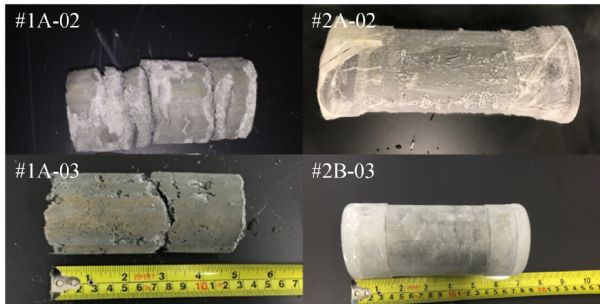

Fundamental characteristics of gas hydrate-bearing sediments in the Shenhu area, South China Sea
Received date: 16 Jun 2020
Accepted date: 17 Aug 2020
Published date: 15 Jun 2021
Copyright
The basic physical properties of marine natural gas hydrate deposits are important to the understanding of seabed growth conditions, occurrence regularity, and occurrence environment of natural gas hydrates. A comprehensive analysis of the core samples of drilling pressure-holding hydrate deposits at a depth of 1310 m in the Shenhu area of the South China Sea was conducted. The experimental results indicate that the particle size in the hydrate sediment samples are mainly distributed in the range from 7.81 µm to 21.72 µm, and the average particle size decreases as the depth of the burial increases. The X-ray CT analytical images and surface characteristics SEM scan images suggest that the sediment is mostly silty clay. There are a large number of bioplastics in the sediment, and the crack inside the core may be areas of hydrate formation.

Key words: natural gas hydrate; Shenhu area; reservoirs characteristics
Xin LYU , Qingping LI , Yang GE , Junlong ZHU , Shouwei ZHOU , Qiang FU . Fundamental characteristics of gas hydrate-bearing sediments in the Shenhu area, South China Sea[J]. Frontiers in Energy, 2021 , 15(2) : 367 -373 . DOI: 10.1007/s11708-020-0714-z
| 1 |
Makogon Y F, Holditch S A, MakogonT Y. Natural gas-hydrates—a potential energy source for the 21st Century. Journal of Petroleum Science and Engineering, 2007, 56: 14–31
|
| 2 |
Sloan E D, Koh C A. Clathrate Hydrates of Natural Gases. 3rd ed. Boca Raton: CRC Press, 2008
|
| 3 |
Zhao J F, Guo X W, Sun M R,
|
| 4 |
Dong H S, Zhang L X, Ling Z,
|
| 5 |
Zhao J F, Wang B, Sum A K. Dynamics of hydrate formation and deposition under pseudo multiphase flow. AIChE Journal, 2017, 63(9): 4136–4146
|
| 6 |
Ripmeester J A, Alavi S. Some current challenges in clathrate hydrate science: nucleation, decomposition and the memory effect. Current Opinion in Solid State and Materials Science, 2016, 20(6): 344–351
|
| 7 |
Moridis G J, Reagan M T, Boyle K L,
|
| 8 |
Zhao J F, Fan Z, Wang B,
|
| 9 |
Song Y C, Kuang Y M, Fan Z,
|
| 10 |
Wang B, Dong H S, Liu Y,
|
| 11 |
Zhao J F, Wang J Q, Liu W G,
|
| 12 |
Feng J C, Wang Y, Li X S,
|
| 13 |
Cheng C X, Zhao J F, Yang M J,
|
| 14 |
Zhao J F, Fan Z, Dong H S,
|
| 15 |
Zhang L X, Zhao J F, Dong H S,
|
| 16 |
Zhao J F, Zhu Z H, Song Y C,
|
| 17 |
Zhao J F, Liu D, Yang M J,
|
| 18 |
Zhang L X, Kuang Y M, Zhang X T,
|
| 19 |
Song Y C, Wang J Q, Liu Y,
|
| 20 |
Wang B, Fan Z, Zhao J F,
|
| 21 |
Song Y C, Cheng C X, Zhao J F,
|
| 22 |
Fan Z, Sun C M, Kuang Y M,
|
| 23 |
Wang B, Fan Z, Wang P F,
|
| 24 |
Wang B, Huo P, Luo T T,
|
| 25 |
Kuang Y M, Yang L, Li Q P,
|
| 26 |
Wu S, Zhang G, Huang Y,
|
| 27 |
Zhang H, Yang S, Wu N,
|
| 28 |
Zhou S W, Chen W, Li Q P,
|
| 29 |
Lu H, Kawasaki T, Ukita T,
|
| 30 |
Shepard F P. Nomenclature based on sand-silt-clay ratios. Journal of Sedimentary Petrology, 1954, 24: 151–158
|
| 31 |
Gustafsson S, Karawacki E, Khan M N. Transient hot-strip method for simultaneously measuring thermal conductivity and thermal diffusivity of solids and fluids. Journal of Physics. D, Applied Physics, 1979, 12(9): 1411–1421
|
| 32 |
Liu C L, Meng Q G, Hu G,
|
/
| 〈 |
|
〉 |